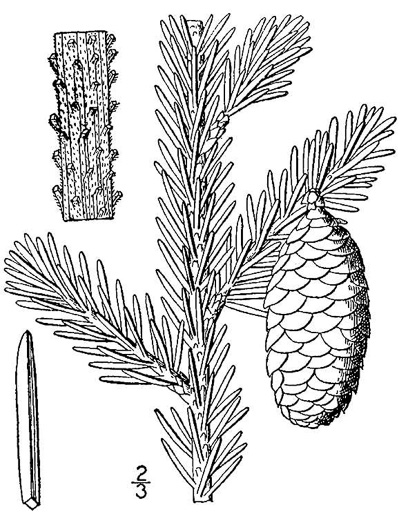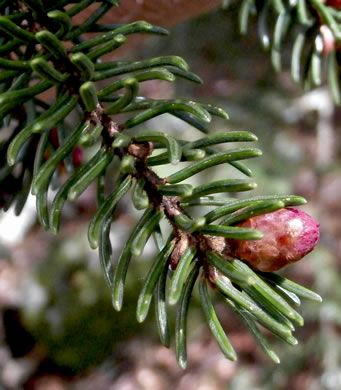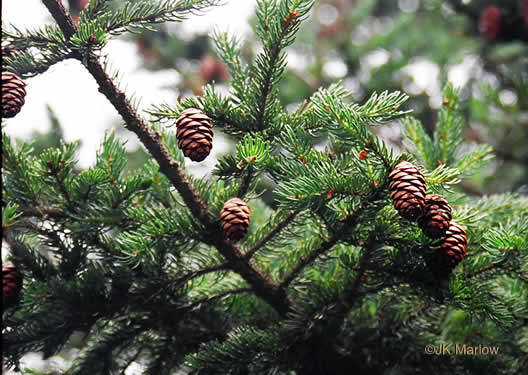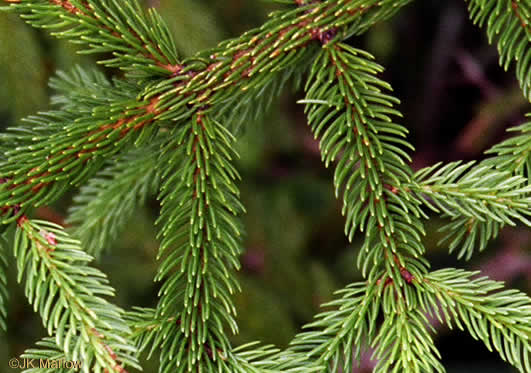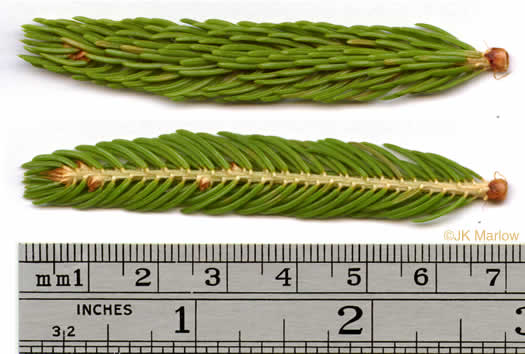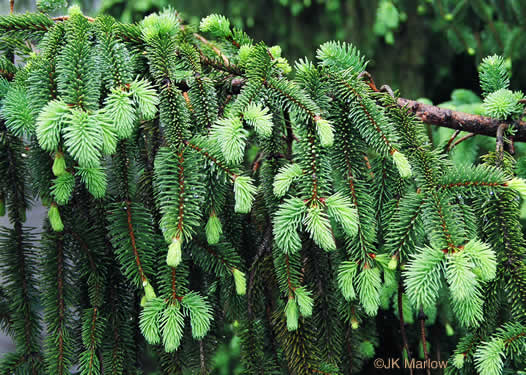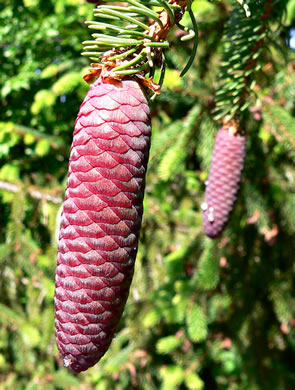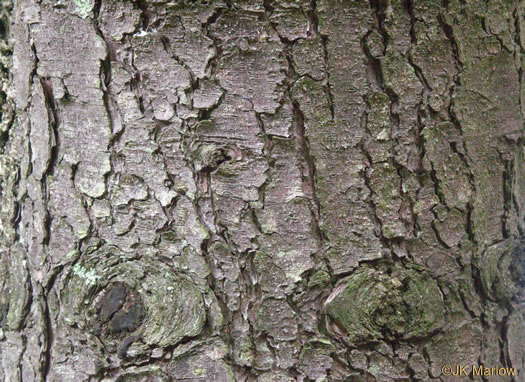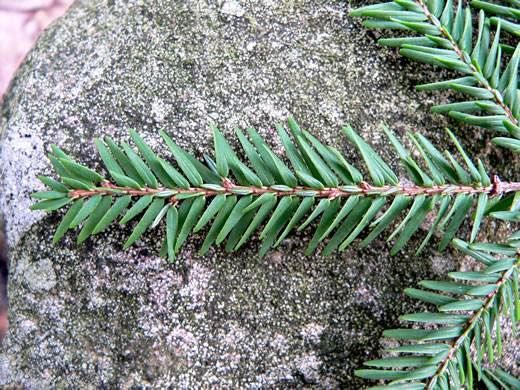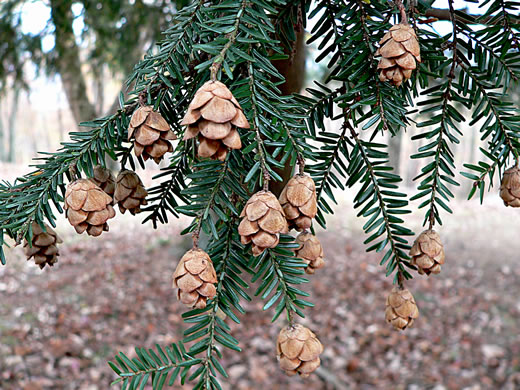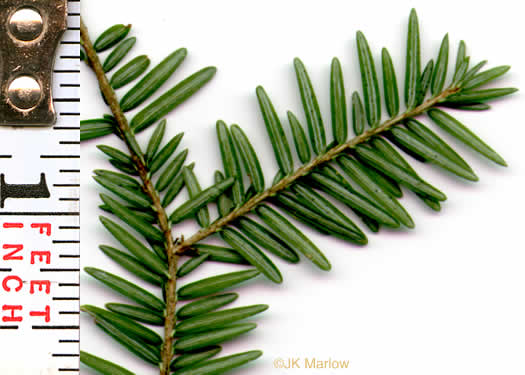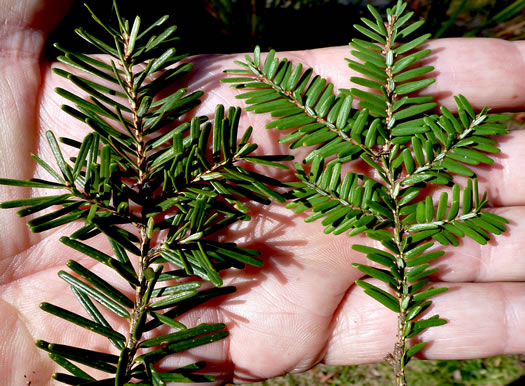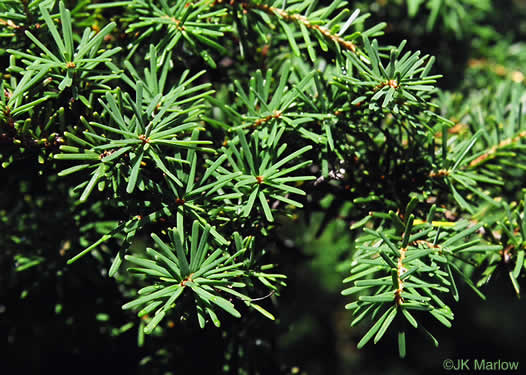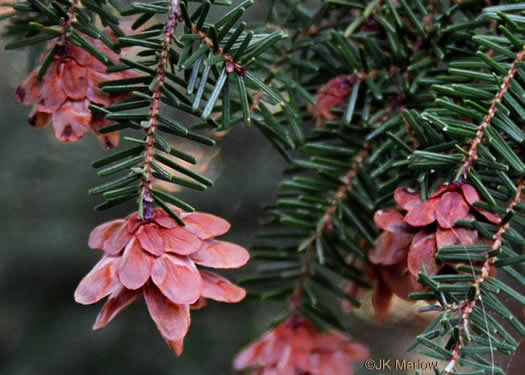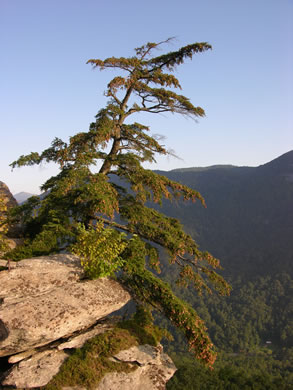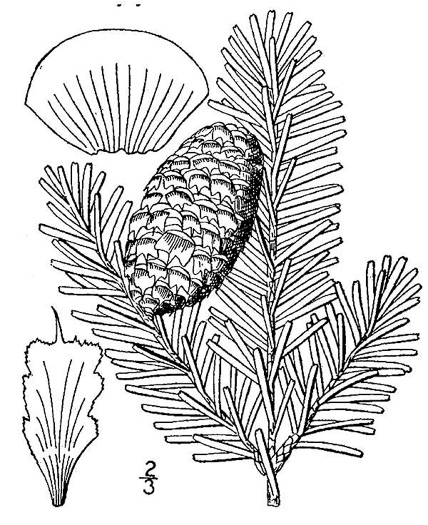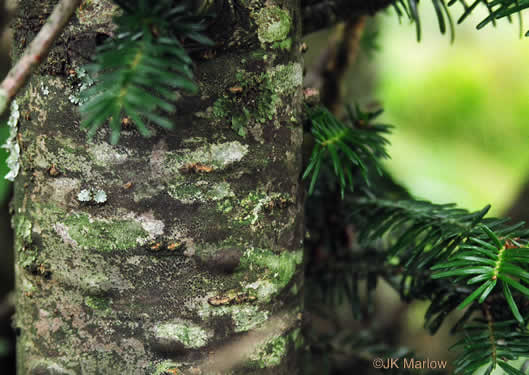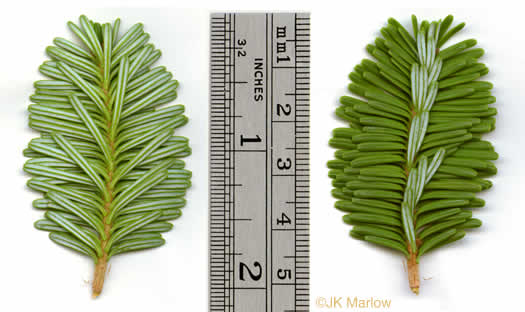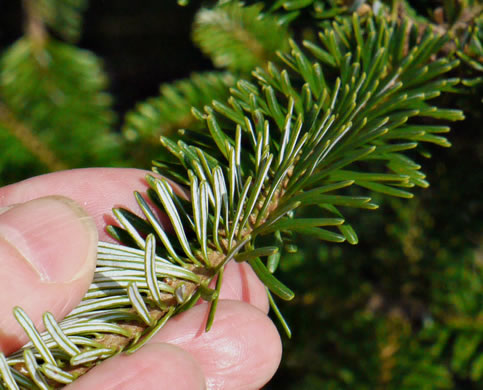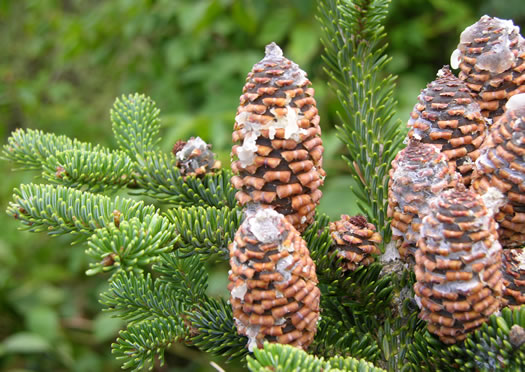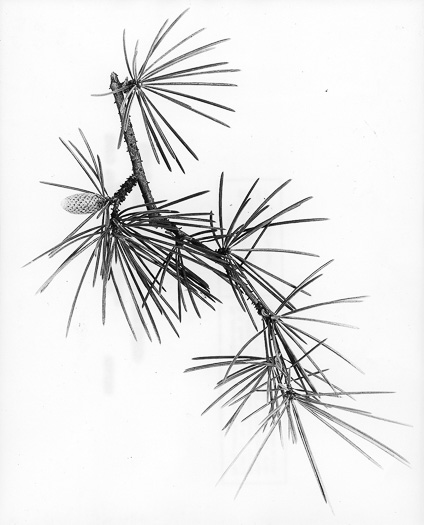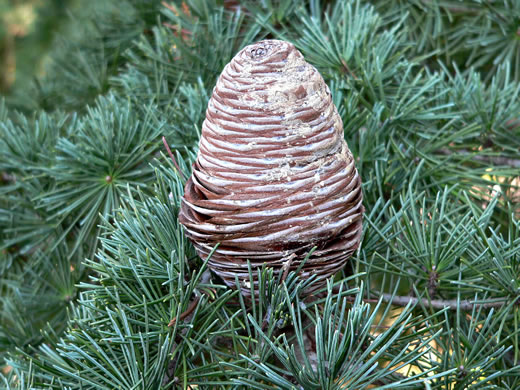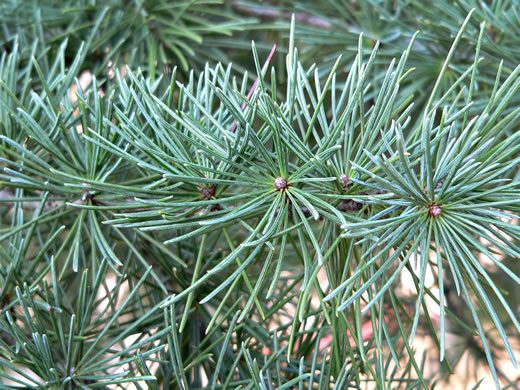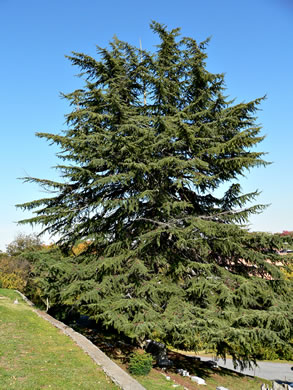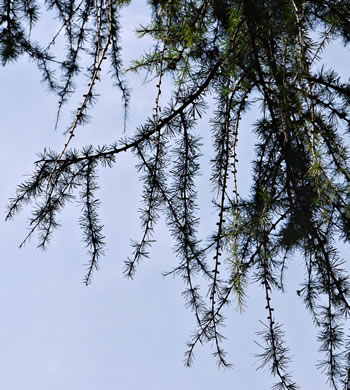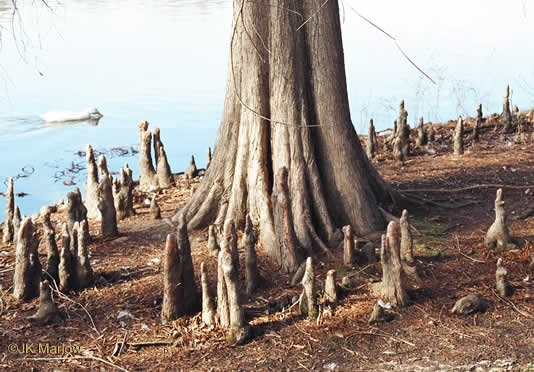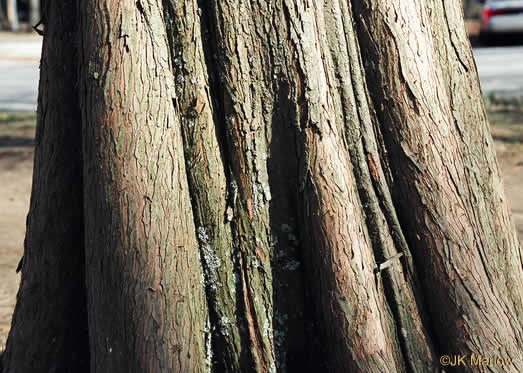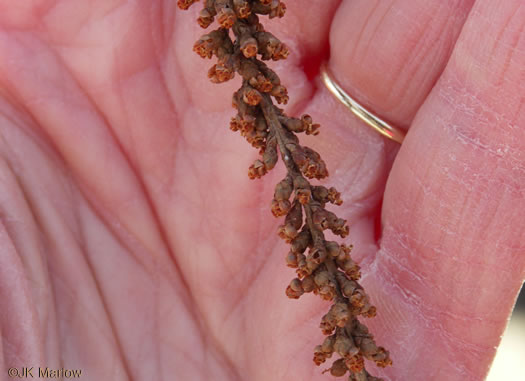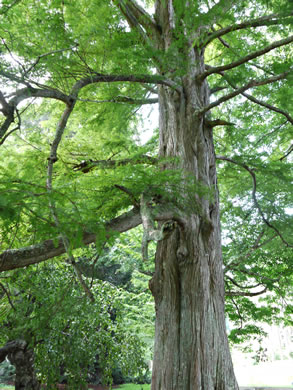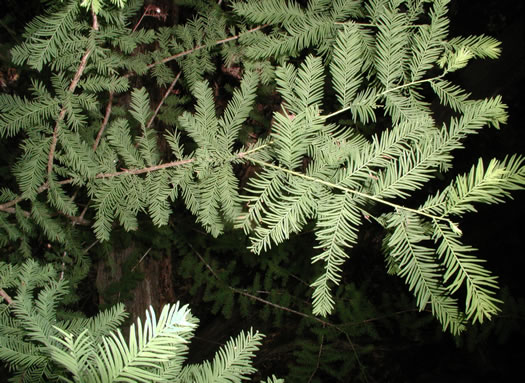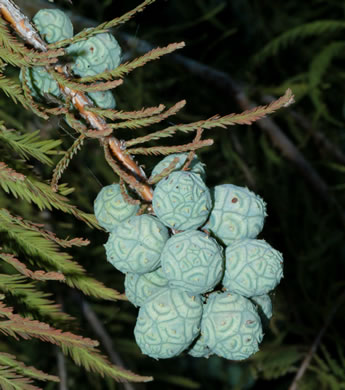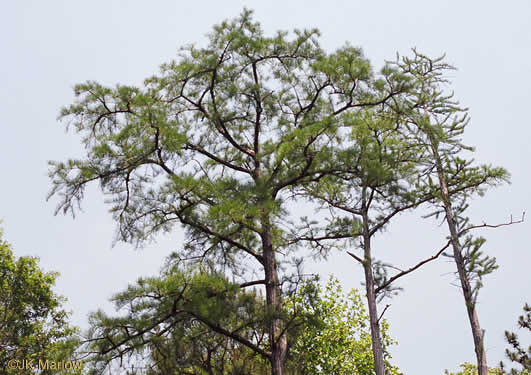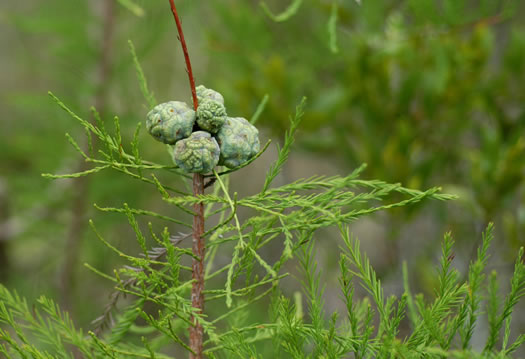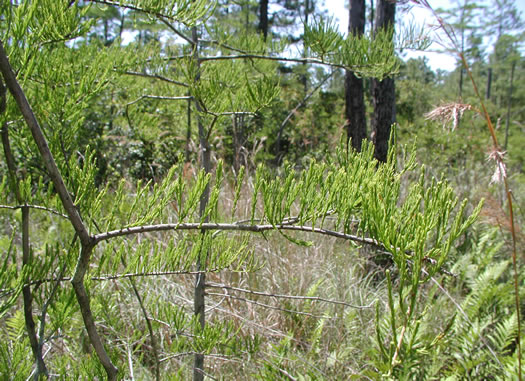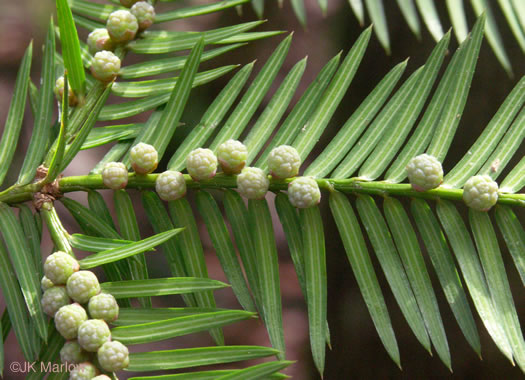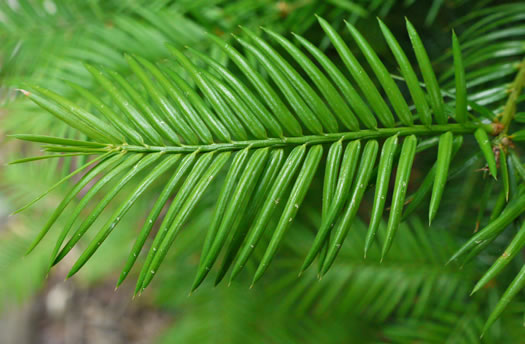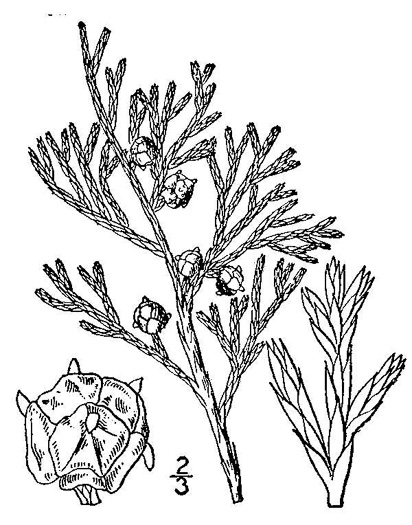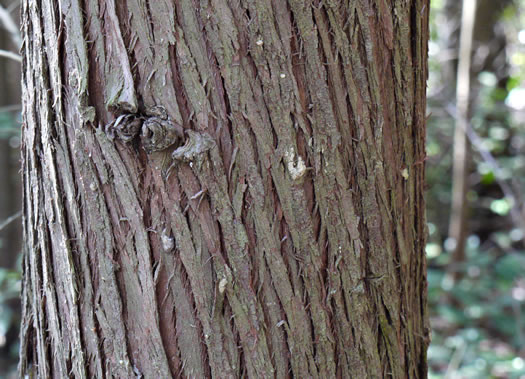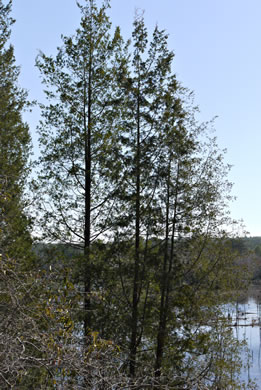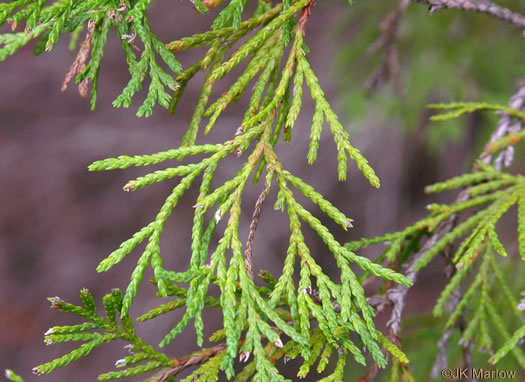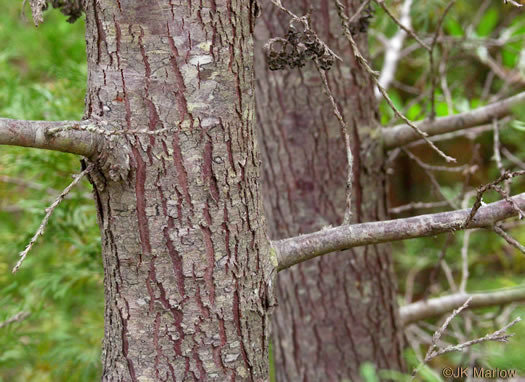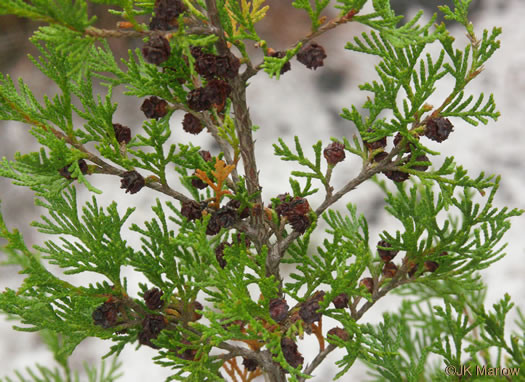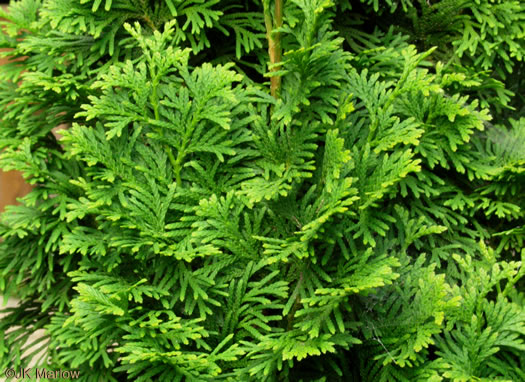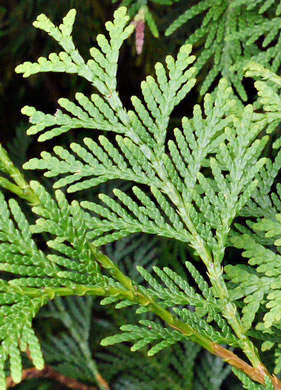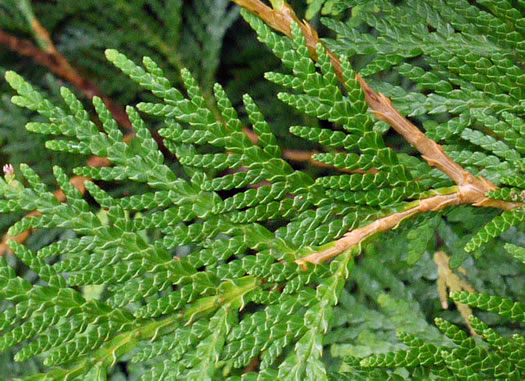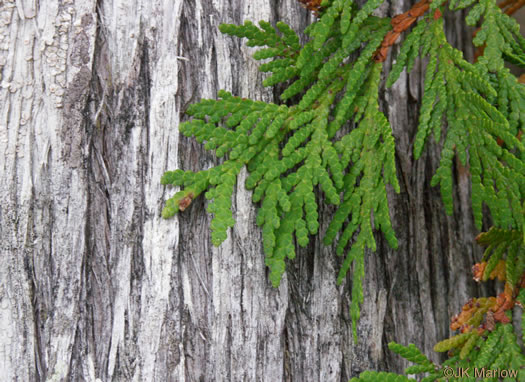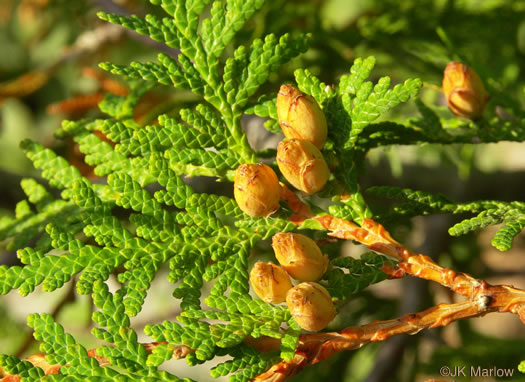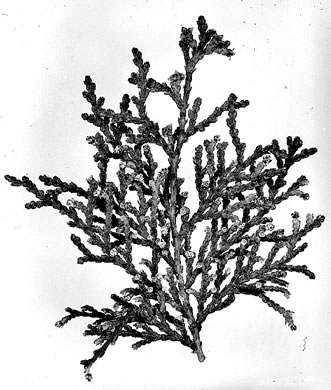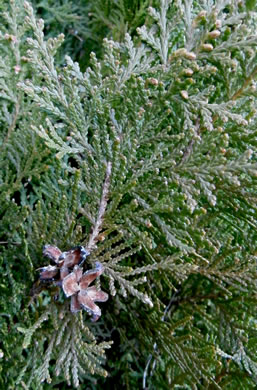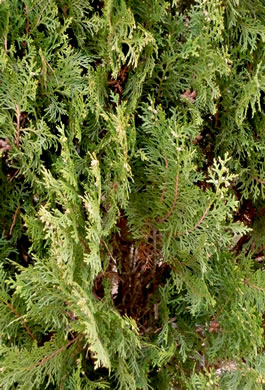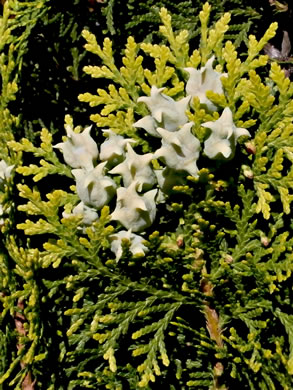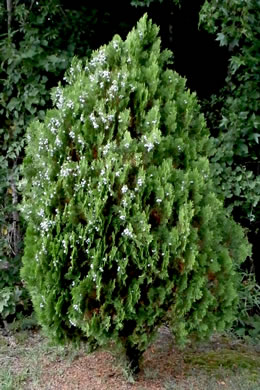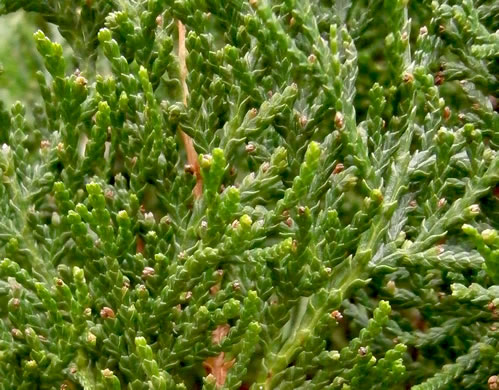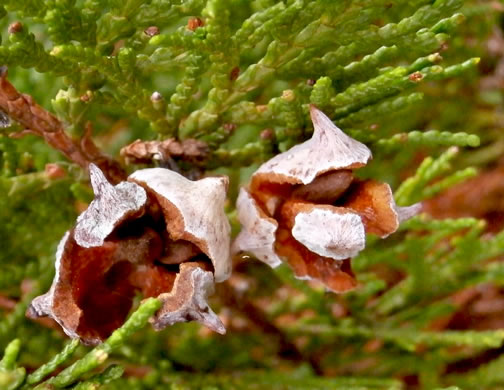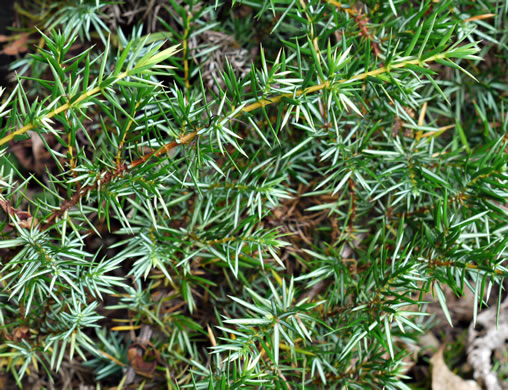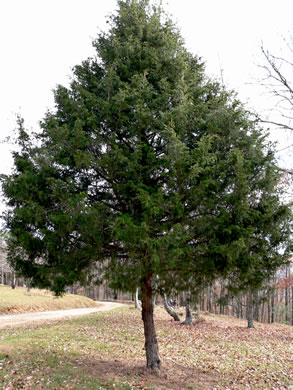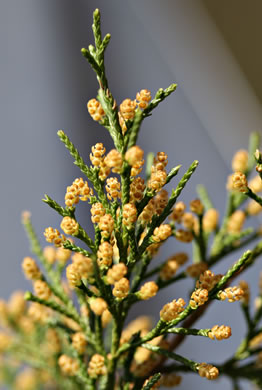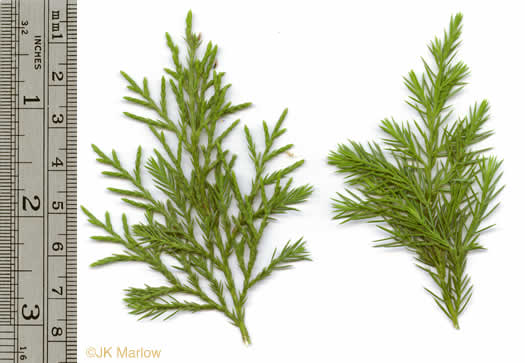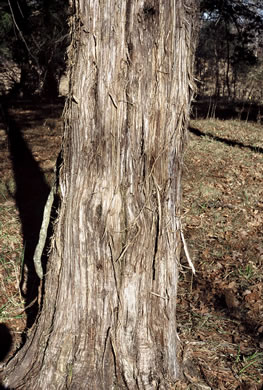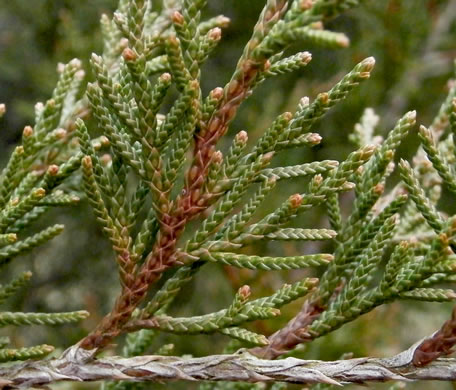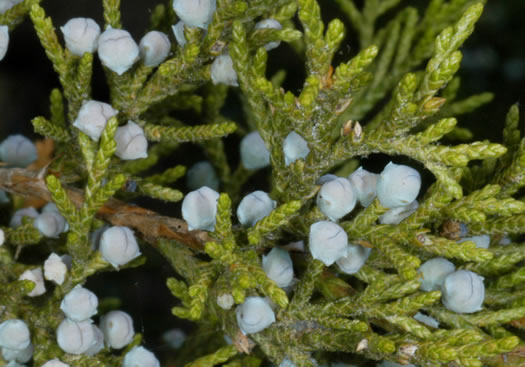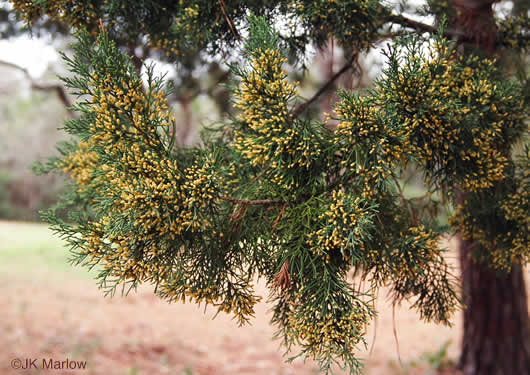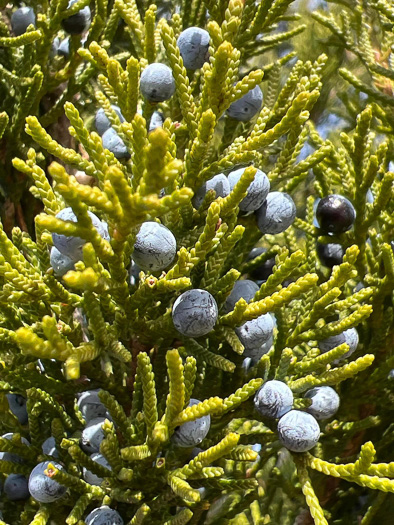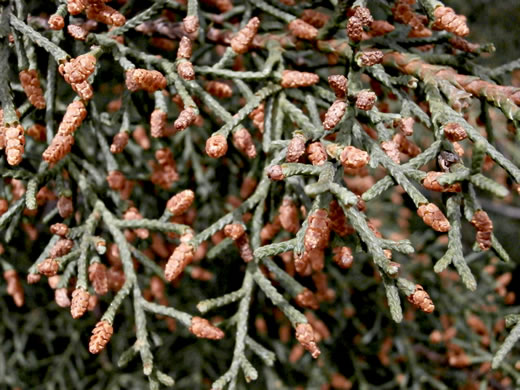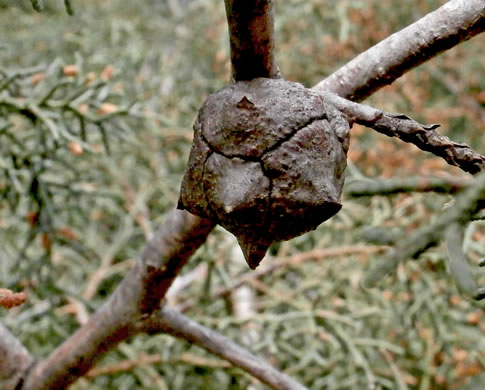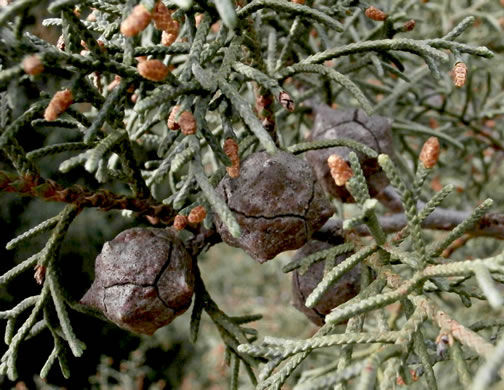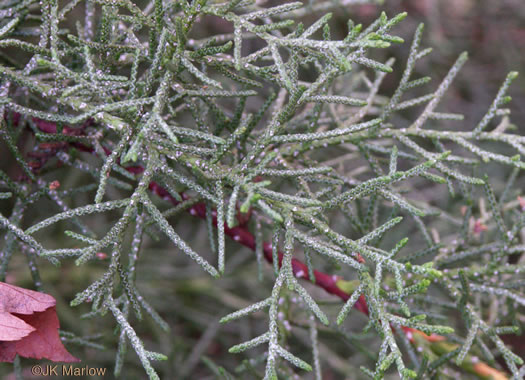Your search found 77 image(s) of conifers (not including Pines).
To see larger pictures, click or hover over the thumbnails.
To go to the plant's detail page, click its name.
 Habitat: Common to dominant in spruce and spruce-fir forests at high elevations, scattered in northern hardwood forests, heath balds, boulderfield forests, ridges, and rarely coves, also in bogs or swampy forests at lower elevations (in NC not below 1000 m), ranging in moisture tolerance from dry ridges (though these are often fog-bathed) to saturated peats, and sometimes planted and naturalized. Picea rubens appears as scattered individuals ("natural waifs") at lower elevations than it is usually found; these seem to reflect sporadic seeding and short term survival and growth from some natural means
Habitat: Common to dominant in spruce and spruce-fir forests at high elevations, scattered in northern hardwood forests, heath balds, boulderfield forests, ridges, and rarely coves, also in bogs or swampy forests at lower elevations (in NC not below 1000 m), ranging in moisture tolerance from dry ridges (though these are often fog-bathed) to saturated peats, and sometimes planted and naturalized. Picea rubens appears as scattered individuals ("natural waifs") at lower elevations than it is usually found; these seem to reflect sporadic seeding and short term survival and growth from some natural means
Pollen cones terminal or subterminal, oval, and bright red at maturity, per Native Trees of the Southeast, An Identification Guide (Kirkman, Brown, & Leopold, 2007).
Cones pendant, 1.25-2" long, reddish-brown, per Woody Plants of the Blue Ridge (Lance).
Needles bright green without white bands below, much shorter than Abies, per Native Trees of the Southeast, An Identification Guide (Kirkman, Brown, & Leopold, 2007).
Leaves 4-sided, per Woody Plants of the Blue Ridge (Lance).
Leaves [needles] attached to peglike bases on twigs, per Woody Plants of the Blue Ridge (Lance).
 Habitat: Fairly commonly planted in the montane and northern parts of our area as a street or yard tree, also persisting and escaping from forestry plantations at moderate or high elevations, notably in e. WV, Great Smoky Mountains National Park (Kephart Prong), Mount Mitchell State Park, and the Biltmore Estate
Habitat: Fairly commonly planted in the montane and northern parts of our area as a street or yard tree, also persisting and escaping from forestry plantations at moderate or high elevations, notably in e. WV, Great Smoky Mountains National Park (Kephart Prong), Mount Mitchell State Park, and the Biltmore Estate
Leaves 4-sided, pointed, attached to peglike bases on twigs, per Woody Plants of the Blue Ridge (Lance).
Cones are pendent, red-brown to gray, over 10cm long, per Woody Plants of the Southeastern US: A Winter Guide (Lance, 2004).
Drooping of twigs & branchlets on lower limbs apparent only on mature trees, per Woody Plants of the Southeastern US: A Winter Guide (Lance, 2004).
 Habitat: In a wide variety of habitats in the mountains, most typically and abundantly in moist sites in ravines or coves along streams, but likely to be found in all but the driest habitats between 300 and 1500 m (even occurring in peaty bogs, where it has a sickly yellow color and short life expectancy); in the western Piedmont of NC limited to progressively rarer microhabitats (primarily north-facing river bluffs), reaching its eastward limit in NC at a disjunct stand at Hemlock Bluff State Natural Area, Wake County (but uncommon in the Piedmont of VA and even present, though rare, in the Coastal Plain of VA)
Habitat: In a wide variety of habitats in the mountains, most typically and abundantly in moist sites in ravines or coves along streams, but likely to be found in all but the driest habitats between 300 and 1500 m (even occurring in peaty bogs, where it has a sickly yellow color and short life expectancy); in the western Piedmont of NC limited to progressively rarer microhabitats (primarily north-facing river bluffs), reaching its eastward limit in NC at a disjunct stand at Hemlock Bluff State Natural Area, Wake County (but uncommon in the Piedmont of VA and even present, though rare, in the Coastal Plain of VA)
Needles 3/8" to 3/4" long, flexible, per Native Trees of the Southeast, An Identification Guide (Kirkman, Brown, & Leopold, 2007).
Cones pendant, small, with thin scales, per Woody Plants of the Blue Ridge (Lance).
Needles 2-ranked, flattened, with 2 narrow whitish bands of stomata beneath, per Native Trees of the Southeast, An Identification Guide (Kirkman, Brown, & Leopold, 2007).
Left: leaves (needles) of Carolina hemlock. Right: Canada or eastern hemlock, per Alpine South: Plants and Plant Communities of the High Elevations of the Southern Appalachians (Gaddy, 2014).
 Habitat: Primarily in open forests on ridge tops, rocky bluffs, or gorge walls, generally in drier and rockier sites than T. canadensis, but the two sometimes growing in close proximity or even intermixed in humid gorges; very limited in the western Piedmont, apparently reaching its eastern limit in NC at Hanging Rock State Park, Stokes County, and ranging east to Halifax County in the Piedmont of VA
Habitat: Primarily in open forests on ridge tops, rocky bluffs, or gorge walls, generally in drier and rockier sites than T. canadensis, but the two sometimes growing in close proximity or even intermixed in humid gorges; very limited in the western Piedmont, apparently reaching its eastern limit in NC at Hanging Rock State Park, Stokes County, and ranging east to Halifax County in the Piedmont of VA
Needles flat, extending in all directions rather than in one plane, per Woody Plants of the Blue Ridge (Lance).
Cones reddish-brown, pendant, to 1-3/8" long, opening widely when mature, per Woody Plants of the Blue Ridge (Lance).
Primarily in open forests on ridge tops, rocky bluffs, or gorge walls, per Weakley's Flora.
Left: leaves (needles) of Carolina hemlock. Right: Canada or eastern hemlock, per Alpine South: Plants and Plant Communities of the High Elevations of the Southern Appalachians (Gaddy, 2014).
 Habitat: High elevation forests, from about 1500-2037 m
Habitat: High elevation forests, from about 1500-2037 m
The bark has resin blisters, per Woody Plants of the Blue Ridge (Lance).
Needles not more than 1" long, green above & with chalky white bands below, per Native Trees of the Southeast, An Identification Guide (Kirkman, Brown, & Leopold, 2007).
Foliage soft to the touch, with a strong resinous odor when rubbed, per Trees of the Southeastern United States (Duncan & Duncan, 1988).
Mature seed cones erect, cylindrical, about 2.5" long, per Native Trees of the Southeast, An Identification Guide (Kirkman, Brown, & Leopold, 2007).
 Habitat: Frequently planted, rarely persistent or possibly escaped to suburban woodlands
Habitat: Frequently planted, rarely persistent or possibly escaped to suburban woodlands
Cones solitary or 2 together on short branchlets, apex rounded, per Manual of Woody Landscape Plants (Dirr, 1975+).
Lvs radially spreading or in apparent fascicles, triangular in cross-section, per Flora of China.
 Habitat: Forests
Habitat: Forests
Cones 2-3.5cm long (vs. 1.2-2cm for L. laricina), per Weakley's Flora (2022).
Leaves 2.5-3cm long (vs. 1-2.5 for L. laricina), per Weakley's Flora (2022).
 Habitat: Brownwater and blackwater swamps, usually in riverine situations, depressions in bottomland forests, lake margins, river banks, rarely in wooded seeps
Habitat: Brownwater and blackwater swamps, usually in riverine situations, depressions in bottomland forests, lake margins, river banks, rarely in wooded seeps
Knees are more narrowly conical & sharp-pointed than knees of pond cypress, per Native Trees of the Southeast, An Identification Guide (Kirkman, Brown, & Leopold, 2007).
Bark brown, fibrous or shreddy on young trunks, thickening with age, per Woody Plants of the Southeastern US: A Winter Guide (Lance, 2004).
Pollen cones produced in elongated, drooping catkins 3-5" long, per Native Trees of the Southeast, An Identification Guide (Kirkman, Brown, & Leopold, 2007).
The deciduous side twigs mostly featherlike, with flat spreading needles, per Woody Plants of the Southeastern US: A Winter Guide (Lance, 2004).
Mature seed cones nearly round, 3/4-1" in diameter, opening at maturity, per Native Trees of the Southeast, An Identification Guide (Kirkman, Brown, & Leopold, 2007).
 Habitat: Limesink ponds (dolines), clay-based Carolina bays, wet savannas, pocosins and other wet, peaty habitats, shores of natural blackwater lakes, swamps of blackwater streams, forming "domes" and "stringers" in Florida in very flat, fire landscapes, also as "hatrack" stands of widely spaced and stunted trees on oolite in south Florida
Habitat: Limesink ponds (dolines), clay-based Carolina bays, wet savannas, pocosins and other wet, peaty habitats, shores of natural blackwater lakes, swamps of blackwater streams, forming "domes" and "stringers" in Florida in very flat, fire landscapes, also as "hatrack" stands of widely spaced and stunted trees on oolite in south Florida
The deciduous side twigs rather threadlike & upturned, w appressed leaves, per Woody Plants of the Southeastern US: A Winter Guide (Lance, 2004).
Mature seed cones nearly round, 3/4-1" in diameter, opening at maturity, per Native Trees of the Southeast, An Identification Guide (Kirkman, Brown, & Leopold, 2007).
Leaves mostly keeled, spirally appressed, and not in a single plane, per Native Trees of the Southeast, An Identification Guide (Kirkman, Brown, & Leopold, 2007).
 Habitat: Moist ravines and bluffs, sometimes planted well outside its native range as an ornamental, and also rarely established near plantings
Habitat: Moist ravines and bluffs, sometimes planted well outside its native range as an ornamental, and also rarely established near plantings
Male cones borne singly in the axils of needles of the previous year, per Manual of Woody Landscape Plants (Dirr, 1975+).
Leaves stiff with a short petiole-like constriction, often slightly curved, per Trees of the Southeastern United States (Duncan & Duncan, 1988).
 Habitat: Peat dome and streamhead pocosins, blackwater stream swamps, hillside seepages, in highly acidic, peaty or sandy soils
Habitat: Peat dome and streamhead pocosins, blackwater stream swamps, hillside seepages, in highly acidic, peaty or sandy soils
Absent in the outer Coastal Plain of SC & GA, occurring primarily in the fall-line Sandhills, per Weakley's Flora (2022).
Its small, evergreen, opposite scale-like leaves aid in recognition, per Trees of the Southeastern United States (Duncan & Duncan, 1988).
Bark gray to reddish-brown, thin, with narrow fissures forming flat ridges, per Native Trees of the Southeast, An Identification Guide (Kirkman, Brown, & Leopold, 2007).
Seed cones become woody, brown, and stalked after opening, per Native Trees of the Southeast, An Identification Guide (Kirkman, Brown, & Leopold, 2007).
 Habitat: Dry limestone, dolostone, and calcareous sandstone cliffs, talus, and boulderfields, rarely in our area in calcareous swamps, also planted and persisting around old homesites and cemeteries (mainly in the Mountains)
Habitat: Dry limestone, dolostone, and calcareous sandstone cliffs, talus, and boulderfields, rarely in our area in calcareous swamps, also planted and persisting around old homesites and cemeteries (mainly in the Mountains)
Branchlets flattened in horizontal planes [T. orientalis's are vertical], per Weakley's Flora (2015).
The small branchlets look as if they had been ironed or pressed, per Vascular Flora of the Carolinas (Radford, Ahles, & Bell, 1968).
Leaves opposite, scale-like, in pairs (the side pairs keeled, others flat), per Native Trees of the Southeast, An Identification Guide (Kirkman, Brown, & Leopold, 2007).
Mature seed cones ~ 1/2" long, oblong, erect, initially yellowish-brown, per Native Trees of the Southeast, An Identification Guide (Kirkman, Brown, & Leopold, 2007).
 Habitat: Commonly planted, especially in graveyards, and rarely persisting and spreading to pastures, fields, and roadsides
Habitat: Commonly planted, especially in graveyards, and rarely persisting and spreading to pastures, fields, and roadsides
Branchlets flattened in vertical planes [T. occidentalis's are horizontal], per Weakley's Flora (2015).
Cones roundish, egg-shaped, 3/4" long, fleshy, bluish before opening, per Manual of Woody Landscape Plants (Dirr, 1975+).
Leaves of Platycladus & Thuja are obtuse; leaves of Chamaecyparis are acute, per Weakley's Flora.
Each of the cone's six scales with a hornlike projection, per Manual of Woody Landscape Plants (Dirr, 1975+).
 Habitat: In thin soil around rock outcrops on mountain summits and Piedmont monadnocks and rocky bluffs (in GA and NC), high elevation old fields (in VA), xeric Coastal Plain sandhills (in SC and VA)
Habitat: In thin soil around rock outcrops on mountain summits and Piedmont monadnocks and rocky bluffs (in GA and NC), high elevation old fields (in VA), xeric Coastal Plain sandhills (in SC and VA)
Leaves all needlelike, spreading from twig, with 1 broad white band on 1 side, per Woody Plants of the Southeastern US: A Winter Guide (Lance, 2004).
 Habitat: Bluffs, glades, upland forests and woodlands, pastures, old fields, roadsides, and fencerows, primarily upland, occurring most abundantly on (but by no means restricted to) circumneutral soils (including shrink-swell clays) derived from mafic or calcareous rocks
Habitat: Bluffs, glades, upland forests and woodlands, pastures, old fields, roadsides, and fencerows, primarily upland, occurring most abundantly on (but by no means restricted to) circumneutral soils (including shrink-swell clays) derived from mafic or calcareous rocks
Crown usually dense and conical, widening with age but rarely flattening, per Woody Plants of the Southeastern US: A Winter Guide (Lance, 2004).
Pollen cones about 1/8" long, terminal, numerous, per Native Trees of the Southeast, An Identification Guide (Kirkman, Brown, & Leopold, 2007).
Leaves on juvenile shoots sharply tipped and subulate, per Woody Plants of the Southeastern US: A Winter Guide (Lance, 2004).
Bark is shreddy, fibrous, per Woody Plants of the Southeastern US: A Winter Guide (Lance, 2004).
Leaves appressed and scalelike (acicular) on mature twigs, per Woody Plants of the Southeastern US: A Winter Guide (Lance, 2004).
Mature seed cones ~ 1/4", berry-like, greenish-blue with whitish coating, per Native Trees of the Southeast, An Identification Guide (Kirkman, Brown, & Leopold, 2007).
 Habitat: Maritime forests and maritime scrub, hammocks, coastal shell middens and natural shell deposits, brackish marshes, pine rocklands in s. FL, and other sandy or peaty, circumneutral situations
Habitat: Maritime forests and maritime scrub, hammocks, coastal shell middens and natural shell deposits, brackish marshes, pine rocklands in s. FL, and other sandy or peaty, circumneutral situations
Crown often ultimately with a flattened and open aspect on old trees, per Woody Plants of the Southeastern US: A Winter Guide (Lance, 2004).
Pollen cones about 1/8" long, terminal, numerous, per Native Trees of the Southeast, An Identification Guide (Kirkman, Brown, & Leopold, 2007).
Mature seed cones ~ 1/4", berry-like, greenish-blue with whitish coating, per Native Trees of the Southeast, An Identification Guide (Kirkman, Brown, & Leopold, 2007).
 Habitat: Fencerows, weakly naturalizing from horticultural plantings
Habitat: Fencerows, weakly naturalizing from horticultural plantings
Pollen cones small, oblong, yellowish, per Manual of Woody Landscape Plants (Dirr, 1975+).
Globose cone with 6-8 flat or depressed scales contracted into short mucros, per Manual of Woody Landscape Plants (Dirr, 1975+).
Scales are peltate, which separates them from Arborvitae, per Manual of Woody Landscape Plants (Dirr, 1975+).
Leaves scale-like, superposed in 4 rows, pointed, pale green to gray-green, per Manual of Woody Landscape Plants (Dirr, 1975+).

